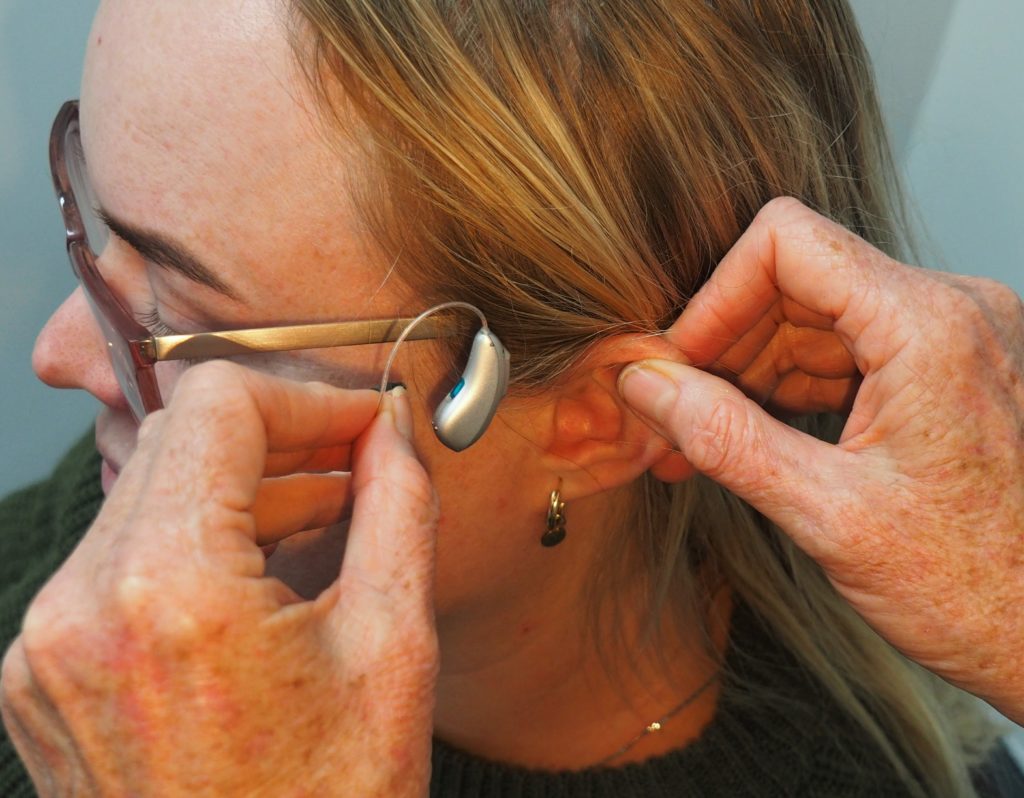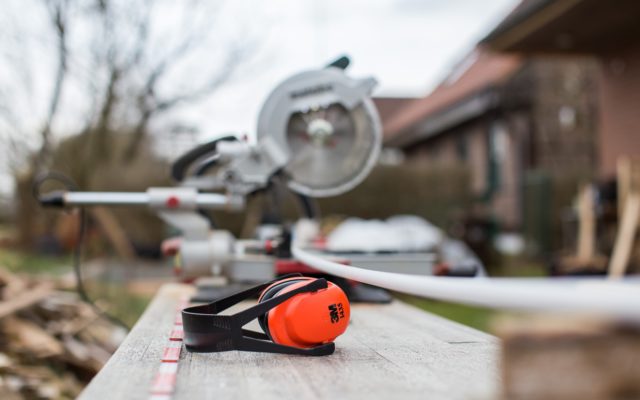
Now Scheduling Primary Care Appointments Online. Book Now.
Audiology

Hearing aids are sound-amplifying devices designed to help people who have hearing loss. Most hearing aids share similar features:
- A microphone that picks up sound.
- Amplifier circuitry that makes the sound louder.
- A miniature loudspeaker (receiver) that delivers the amplified sound into the ear canal.
- Batteries that power the electronic parts.
Hearing aids differ by design, technology used to achieve amplification (analog or digital), and features such as wireless connectivity and software applications. Some hearing aids also have earmolds or earpieces to direct the flow of sound into the ear and enhance sound quality. Hearing aid selection is based on the type and severity of hearing loss, listening needs, and lifestyle.
Oaklawn’s Audiology team wants to make sure you have updated information on the latest technology. Make sure to discuss all options with our audiologists to ensure the best hearing outcome for you!
Hearing Aid Styles
Hearing aids vary a great deal in price, size, special features and the way they’re placed in your ear.
The following are common hearing aid styles, beginning with the smallest, least visible in the ear. Hearing aid designers keep making smaller hearing aids to meet the demand for a hearing aid that is not very noticeable. But the smaller aids may not have the power to give you the improved hearing you may expect.
Completely in the canal (CIC) or mini CIC
A completely-in-the-canal hearing aid is molded to fit inside your ear canal. It improves mild to moderate hearing loss in adults.
A completely-in-the-canal hearing aid:
- Is the smallest and least visible type
- Is less likely to pick up wind noise
- Uses very small batteries, which have shorter life and can be difficult to handle
- Often doesn’t include extra features, such as volume control or a directional microphone
- Is susceptible to earwax clogging the speaker
In the canal
An in-the-canal (ITC) hearing aid is custom molded and fits partly in the ear canal. This style can improve mild to moderate hearing loss in adults.
An in-the-canal hearing aid:
- Is less visible in the ear than larger styles
- Includes features that won’t fit on completely-in-the-canal aids, but may be difficult to adjust due to its small size
- Is susceptible to earwax clogging the speaker
In the ear
An in-the-ear (ITE) hearing aid is custom made in two styles — one that fills most of the bowl-shaped area of your outer ear (full shell) and one that fills only the lower part (half shell). Both are helpful for people with mild to severe hearing loss and are available with directional microphones (two microphones for better hearing in noise).
An in-the-ear hearing aid:
- Includes features that don’t fit on smaller style hearing aids, such as a volume control
- May be easier to handle
- Uses a larger battery for longer battery life, with several options for rechargeable batteries
- Is susceptible to earwax clogging the speaker
- May pick up more wind noise than do smaller devices
- Is more visible in the ear than smaller devices
Behind the ear
A behind-the-ear (BTE) hearing aid hooks over the top of your ear and rests behind the ear. A tube connects the hearing aid to a custom earpiece called an ear mold that fits in your ear canal. This type is appropriate for people of all ages and those with almost any type of hearing loss.
A behind-the-ear hearing aid:
- Traditionally has been the largest type of hearing aid, though some newer mini designs are streamlined and barely visible
- Has directional microphones
- Is capable of more amplification than are other styles
- May pick up more wind noise than do other styles
- May be available with a rechargeable battery
Receiver in canal or receiver in the ear
The receiver-in-canal (RIC) and receiver-in-the-ear (RITE) styles are similar to a behind-the-ear hearing aid with the speaker or receiver that sits in the ear canal. A tiny wire, rather than tubing, connects the piece behind the ear to the speaker or receiver.
A receiver-in-canal hearing aid:
- Typically has a less visible behind-the-ear portion
- Has directional microphones
- Has manual control options
- May be available with rechargeable battery
- Is susceptible to earwax clogging the speaker
Open fit
An open-fit hearing aid is a variation of the behind-the-ear hearing aid with a thin tube or the receiver-in-the-canal or receiver-in-the-ear hearing aid with an open dome in the ear. This style keeps the ear canal very open, allowing for low-frequency sounds to enter the ear naturally and for high-frequency sounds to be amplified through the hearing aid. This makes the style a good choice for people with better low-frequency hearing and mild to moderate high-frequency hearing loss.
An open-fit hearing aid:
- Is often visible
- Doesn’t plug the ear like the in-the-ear hearing aid styles, often making your own voice sound better to you
- May be more difficult to insert into the ear due to the noncustom dome
Additional Features
Some optional features of hearing aids improve your ability to hear in specific situations:
Noise reduction. All hearing aids have some amount of noise reduction available. The amount of noise reduction varies. Some also offer wind noise reduction.
Directional microphones. These are aligned on the hearing aid to provide for improved pickup of sounds coming from in front of you with some reduction of sounds coming from behind or beside you. Some hearing aids are capable of focusing in one direction. Directional microphones can improve your ability to hear when you’re in an environment with a lot of background noise.
Rechargeable batteries. Some hearing aids have rechargeable batteries. This can make maintenance easier for you by eliminating the need to regularly change the battery.
Telecoils. Telecoils make it easier to hear when talking on a telecoil-compatible telephone. The telecoil reduces the sounds from your environment and picks up the sounds from the hearing-aid-compatible telephone. Telecoils also pick up signals from public induction loop systems that can be found in some churches and theaters, allowing you to hear a speaker, play or movie better.
Wireless connectivity. Increasingly, hearing aids can wirelessly interface with certain Bluetooth-compatible devices, such as cellphones, music players, computers and televisions. You may need to use an intermediary device to pick up the phone or other signal and send it to the hearing aid.
Remote controls. Some hearing aids come with a remote control, so you can adjust features without touching the hearing aid. Some hearing aids connect wirelessly to a cellphone and have a cellphone application that allows use of the cellphone as a remote control.
Direct audio input. This feature allows you to plug in to audio from a television, a computer or a music device with a cord.
Variable programming. Some hearing aids can store several preprogrammed settings for various listening needs and environments.
Synchronization. For an individual with two hearing aids, the aids can be programmed to function together so that adjustments made to a hearing aid on one ear (volume control or program changes) will also be made on the other aid, allowing for simpler control.
Source: Mayo Clinic Staff. (2022, September 20). Hearing aids: How to choose the right one. Mayo Clinic. Retrieved January 16, 2023, from https://www.mayoclinic.org/diseases-conditions/hearing-loss/in-depth/hearing-aids/art-20044116

